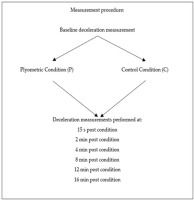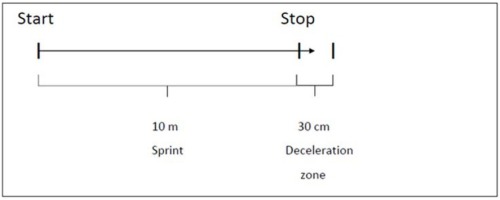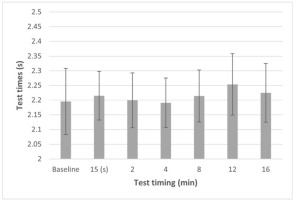Introduction
In many sports, the act of rapidly slowing the body (deceleration) is a key factor to the success of the movement (Hewit et al., 2011). Deceleration plays an important role in the players’ movement patterns in many team sports, such as soccer (Vigh-Larsen et al., 2018), field hockey (Chesher et al., 2019), rugby (Delaney et al., 2017) and others. In these team sports, running requires changes in velocity through acceleration and deceleration (Williams et al., 2017). In fact, during a game, the ability to rapidly change velocity and direction is a key factor for the outcome of many technical actions (Chaouachi et al., 2012), such as regaining the ball after a loss of possession and evading opposition tackles (Mara et al., 2017). Indeed, according to the agility’s deterministic model proposed by Sheppard and Young (2006), the player is required to suddenly adapt his own movement to that of his opponent and the current situation.
In a study on elite female soccer (Mara et al., 2017), players performed on average 430 decelerations per match, with differences in intensity according to their position and the time period of the match. Furthermore, Dalen et al. (2016) also demonstrated that decelerations contributed to 5 – 7% of the total player load during a match, and not considering their energy cost could lead to an underestimation of the player’s match total load (Gaudino et al., 2013). For this reason, it has been suggested how the use of only speed and distance variables to assess the physical demands of soccer players may be limited. In fact, high intensity activities such as jumping, acceleration or deceleration may be classified in the low-speed locomotor category, although they represent a high physical strain for the player (Dalen et al., 2016).
The primary muscles used to decelerate in running actions are the quadriceps and gastrocnemius, working through eccentric muscle actions to absorb and disperse the impact forces, which can be very high if the time available to absorb them is limited (Hewit et al., 2011). It has been proposed that strength and power play an important role in decelerating, involving the muscular stretch-shortening cycle (SSC) (Harper et al., 2018; Kovacs et al., 2008).
PAP has been defined as the phenomena by which muscular performance characteristics are acutely enhanced as a result of their contractile history (Tillin and Bishop, 2009). PAP can acutely increase muscular power and, consequently, performance (Wilson et al., 2013). PAP is induced by a voluntary conditioning contraction (CC), performed typically at maximal or near-maximal intensity, and has consistently been shown to increase peak force and, especially, the rate of force development (RFD) during subsequent twitch contractions, enhancing the mechanical power (Force×Velocity) and then the sport performances largely determined by it (Hodgson et al., 2005; Tillin and Bishop, 2009). The hypothesized mechanisms responsible for PAP are the phosphorylation of myosin regulatory light chain (RLC), an increase in the recruitment of higher order motor units and a decrease in the muscular pennation angle (Tillin and Bishop, 2009). After a conditioning activity, mechanisms of muscular fatigue and potentiation (PAP) coexist, and the subsequent power output and performance depend on the balance between these two factors (Wilson et al., 2013). Fatigue subsides at a faster rate than PAP, and a potentiated performance can be realized at some point during the recovery period (Tillin and Bishop, 2009). According to Sale (2004), a more intense and prolonged conditioning activity may activate the PAP mechanisms to a greater extent, but it also produces greater fatigue. A longer recovery period between the end of the conditioning activity and the beginning of the performance may lead to a greater recovery from fatigue, but also to greater decay of the PAP.
There is a combination of several variables influencing the magnitude of PAP and its relationship with fatigue: volume, intensity and the type of the CC performed, subject characteristics such as training status and fibre-type distribution, the type of the activity performed after the CC, rest period length and others (Robbins, 2005; Tillin and Bishop, 2009; Wilson et al., 2013). By the meta-analysis of Wilson et al. (2013), it has been shown that moderate rest period lengths (7-10 min) may elicit the best power output after a conditioning activity, but more trained people may benefit of a shorter recovery time (3-7 min) to have the greatest PAP effects. Because of high inter-subject variability in morphological, physiological, and other values, Gołaś et al. (2016) also highlighted the importance to provide athletes with an individualized recovery time, in order to benefit of the personal highest potentiating effect. It was also shown that both isometric and dynamic muscle actions may elicit PAP, but through different mechanisms (Tillin and Bishop, 2009; Wilson et al., 2013). Regarding the dynamic actions, Krzysztofik et al. (2020) showed that the eccentric and concentric phases of a movement, when performed singularly, might elicit different outcomes.
While many studies showed an improvement of power activities (jumps and sprints) using heavy resistance exercises (~90% 1 RM) (Bevan et al., 2010; Boullosa et al., 2013; Saez Saez de Villarreal et al., 2007), some authors suggested that ballistic (plyometric) activities may be used to elicit PAP (Maloney et al., 2014; Turner et al., 2015), also because of their kinematic similarities to subsequent explosive sport activities (Tillin and Bishop, 2009). Plyometric training (PLY), using muscle actions which rely on the stretch-shortening cycle (SSC), has already been used as a training method to improve neuromuscular function and to improve both explosive and endurance performance, and it is considered as a bridge between strength and speed, therefore power (Markovic and Mikulic, 2010). Indeed, it has been reported that, using plyometric conditioning activities, the recovery time needed to observe the greatest PAP effects may be lower than would be with the use of heavy resistance exercise, suggesting that plyometric activities may elicit less fatigue (Krzysztofik et al., 2021, for upper limbs; Maloney et al., 2014, for lower limbs). In fact, with the use of plyometric conditioning activities, recovery duration of 1-6 min has been shown to successfully elicit PAP in many cases, with performance improvements between 2 and 5%, like those induced by heavy resistance exercise (Maloney et al., 2014). The effects of PAP elicited by plyometric exercise on the subsequent sprint acceleration performance (over 20 m, with a split at 10 m) have been investigated by Turner et al. (2015). In that study, the acceleration performance was evaluated at baseline, 15 s, 2, 4, 8, 12 and 16 min after the intervention protocols (control, plyometric or weighted plyometric). Results showed that 10-m sprint performance of plyometric condition was enhanced at the 4th min of recovery relative to its own baseline and to the same-time performance of the control condition. Results also suggested that, with the addition of a weighted vest, greater fatigue may be firstly elicited, but a greater PAP-induced enhanced performance later.
Therefore, since PAP has been shown to improve subsequent power performance, considering that there are many biomechanical differences between acceleration and deceleration in sport (Hewit et al., 2011), and given that deceleration is a high intensity activity as common as acceleration in soccer (Dalen et al., 2016; Osgnach et al., 2010), it could be worthy to study the effect of a PAP protocol on the motor ability to decelerate. Therefore, the aim of this study was to investigate whether the submission of a plyometric protocol presented by Turner et al. (2015) might elicit the PAP and thus improve the subsequent deceleration performance in soccer players. Since it has been recently proposed to refer to as PAP only for laboratory studies on single twitches using electrical stimulations, while preferring the term Postactivation Performance Enhancement (PAPE) for applied strength and conditioning research (jumps, sprints and explosive actions) (Blazevich and Babault, 2019; Prieske et al., 2020), we would now refer to our results with the term of PAPE.
Methods
Experimental approach to the problem
To investigate the effects of a plyometric load on subsequent deceleration performance, the protocol provided by Turner et al. (2015) was used. The only difference was that in our current study the plyometric weighted condition was not applied. However, accordingly with the above-mentioned study, a full control condition which did not include the execution of the preload stimulus was added to the research design to avoid the possible covariate additive effects (fatiguing or potentiating) from repeated maximal performance efforts (deceleration tests).
Participants
Eighteen (18) male university student soccer players (age 22 ± 2 years) voluntarily took part in this study. All the participants were members of the University of Rome “Foro Italico” soccer team and they were engaged in three training sessions and one official match weekly. Participants had no previous muscular injures in the last 60 days before the evaluations. All the players had a multi-year experience in soccer and plyometric training. An informed consent form based on the Declaration of Helsinki ethical principles for medical research involving human subjects was read and signed prior to testing and informed consent was obtained from all participants before enrollment and testing. Since the sample involved only players (all students) of the university soccer team, the study was approved by the internal review board of the Department of Sport and Human Movement of the University of Rome Foro Italico, which evaluates and gives the required ethics approvals for activities and testing involving its sport teams.
Design and Procedures
Before the two experimental sessions (day 1 and 2) where participants performed the P and C conditions, respectively, a familiarization session in which they practiced both the deceleration and plyometric test protocol was attended. The two testing sessions were divided by 96 hours. All sessions were planned at the same time of the day and on the same artificial-grass soccer field where participants had trained during the season. Participants were instructed to minimize the foot contact time and maximize the horizontal (rather than vertical) impulse during the execution of plyometric bounds, according to Turner et al. (2015). During the two experimental trials, participants performed the same standardized warm-up used in the study by Turner et al. (2015), which consisted of jogging (~3 min), dynamic stretching exercises for the musculature primarily involved in the subsequent explosive activities (~10min), increasing-intensity sprints and decelerations (decelerations were the only addition in the warm-up protocol) for ~5 min. After an active recovery of 2 min, participants performed the baseline deceleration test, followed by a further active recovery period of 2 min which preceded the execution of Plyometric condition (P) (on the first session day) or the walking control condition (C) (on the second session day). Finally, participants performed again the deceleration test at 15 s, 2, 4, 8, 12 and 16 min after the respective condition (P and C) (Figure 1).
Under the plyometric condition (P), participants performed three sets of ten alternate-leg bounds (five contacts per leg per set). Once completed the first set, they were instructed to walk back to the starting position and perform the further two sets in a similar manner. Each set (bounds plus recovery to the starting position) lasted for ~25 s, as prescribed previously in the protocol by Turner et al. (2015). Under the control condition (C), participants were instructed to continuously walk for ~75 s in order to minimize losses in body temperature relative to the P condition, which lasted about the same amount of time.
Measures
The ability to quickly decelerate was evaluated by measuring the time to perform a task of acceleration and deceleration over a distance of 10 m followed by a deceleration zone of 30 cm (Figure 2), by means of infrared timing gates (Polifermo, Microgate, Italy) positioned at 0 m (start) and 10 m (finish). Participants had to perform a maximal acceleration, then decelerate and stop quickly into a 30-cm deceleration zone placed beyond the finish line at 10 m, which was meant to make participants perform a maximal deceleration (at the end of the maximal acceleration). When a participant did not stop within the limited breaking zone, the trial was considered not valid and thus repeated. A member of the research staff provided verbal encouragement to the participants in order to assure their maximal effort until the finish line.
Statistical analysis
Statistical analyses were performed using SPSS software (Version 23.0, SPSS Inc., Chicago, IL, USA). Data are presented as mean ± SD. The level of significance was set at p ≤ 0.05. Before the statistical analysis, the Shapiro-Wilk test of normality was used, showing that data were normally distributed. To examine any potential learning effect between the baselines of P (day 1) and C (day 2) conditions, pairwise comparison was applied with a paired t-test. The magnitude of differences between consecutive trials within each condition (P and C) was also expressed as standardized mean difference (Cohen effect sizes, ES). Thresholds of ES were set at ≤ 0.2, 0.21–0.5, 0.51–0.8, and ≥ 0.8 for trivial, small, moderate, and large magnitudes of effect, respectively. The spreadsheet of Hopkins was also used to determine the change in the mean between trials and the typical error of measurement (TE, s), expressed as a coefficient of variation (CV, %), between the baseline and the following trial at 15 s of the Control condition (C). Two-way (2 × 7) repeated measures analyses of variance (within-subject factors: condition [C, P] × time [baseline, 15 s, 2, 4, 8, 12 and 16 min]) were used. The Mauchly’s test was carried out and Greenhouse-Geisser correction was applied if sphericity was violated. Pairwise comparisons (t-tests) were undertaken for significant main effects for the six comparisons of time made for each condition (P and C) to determine differences between the baseline deceleration performance and each of the subsequent intervals’ performances.
Results
The times (mean ± SD) to perform the 10-m deceleration test at different time periods (from baseline to the 16th min) for both P and C experimental conditions are shown in Figures 3 and 4, respectively. ANOVA for repeated measures showed a significant difference (p < 0.001) between conditions (P and C) and recovery duration, respectively (15 s, 2, 4, 8, 12 and 16 min). A significant difference (p < 0.05) was also found for the interaction condition × recovery duration. The post-hoc analysis for P demonstrated that the deceleration test performed at the 2nd min after the preload stimulus was significantly faster than the baseline one (p = 0.042; ES = 0.86, large effect; Δ time = - 4.13 %), while no significant differences were found for C condition. A comparison between the two experimental conditions (P and C) is also shown in Figure 5. As expected, the pairwise analysis revealed a significant difference between the baselines of P (day 1) and C (day 2), due to a learning effect. The assessment of reliability between the baseline and the following trial at the 15th s of the Control condition (C) showed values of 0.05 of TE (0.04 – 0.08) and 2.4% of CV (1.8 – 3.7). The plain times of performance (mean ± SD) and differences expressed in percentages (%) between baseline and the other time-period (15 s, 2, 4, 8, 12 and 16 min after the preload stimulus) for P condition are shown in Table 1.
Figure 3
Mean ± SD of deceleration test times of the Plyometric condition (P). * Significant difference from baseline (p ≤ 0.05). Note: lower values mean improvement of performance compared to baseline measurement.
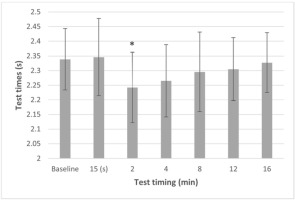
Figure 5
Mean ± SD of deceleration test times of the Plyometric (P) and Control (C) conditions.
* Significant difference from the relative baseline (p ≤ 0.05).
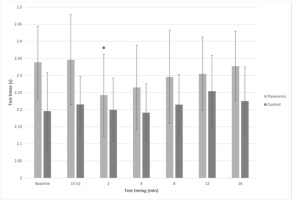
Table 1
Mean ± SD and differences in time expressed in percent (Δ %) between deceleration test times and the relative baseline under P condition.
Discussion
To the authors’ best knowledge, this is the first study to investigate the effectiveness of PAPE evoked by a plyometric protocol on the ability to decelerate in soccer players. The main finding of this study is that PAPE evoked a significant improvement in the players’ deceleration performance at the 2nd min from its execution, which is also supported by the fact that no significant differences were found between the baseline and the following deceleration performances when the C condition was applied. In terms of percentages, the result of the deceleration trial performed 2 minutes after the plyometric preload stimulus improved by 4% compared to its relative baseline, in line with the findings of Maloney et al. (2014) who stated that PAP(E)-related improvements typically range from 2 to 5%.
Turner et al. (2015), using the same plyometric protocol as in the current study to assess accelerations, found performance improvements 4 min after the preload stimulus and not after only 2 min, as in our case. According to Wilson et al. (2013), this fact might suggest that our participants could have experienced less fatigue performing the plyometric protocol compared to Turner’s participants. The reason of such fatigued condition could be due to their probable higher training status, fatigue resistance and a certain ability to decelerate. The latter can also be ascribed to the fact that a part of soccer players’ training load is represented by decelerations themselves, so they could be likely more habituated to perform them. Despite the fact that plyometric activities always involve both concentric and eccentric muscular actions, performing the 10-consecutive plyometric bounces as in our and Turner's study (participants were instructed to minimize the foot contact period) may be biomechanically more similar to the rapid concentric actions of sprinting (< 250 ms) than to the longer eccentric phases of braking (Young and Elliott, 2001). According to Sale (2004), this would result in a greater activation of the concentric phases, therefore greater fatigue, and eventually in later PAPE effects than in Turner et al.’s study (4 min) in respect to ours (2 min). Moreover, when performing a complete stop is required, running braking forces and impulses (vertical, horizontal and their resultant) appear also to be higher than propulsive ones (Dos’Santos et al., 2020).
The deceleration test executed after 15 s from the plyometric stimulus was not different compared to its relative baseline, with only a slight decrease in performance (Δ time = + 0.31%). In fact, fatigue and PAP coexist, and subsequent performance depends on the balance between these two factors (Wilson et al., 2013). Our findings suggest that the optimal window with the most effective PAPE/fatigue ratio and in which deceleration performance should be executed is at the 2nd min from the preload stimulus. While the meta-analysis by Wilson et al. (2013) recommends recovery periods of 7-10 min for optimizing performance enhancements, our results are more in line with those from Maloney et al. (2014) who recommend a rest interval of 1-6 min after plyometric activities as a preload stimulus. A possible explanation could be that the plyometric activity causes less fatigue compared to heavy loading close to 1 RM, causing earlier enhancing effects (Tillin and Bishop, 2009).
Supporting this assumption, Turner et al. (2015) found improvements in the acceleration performance of university students at the 4th min from the plyometric conditioning activity, while Bevan et al. (2010) showed the best improvements in acceleration performance at the 8th min following a heavy resistance protocol, although in elite rugby players. This discrepancy in the optimal recovery time between Turner et al. and Bevan et al.’s studies could have been even greater if participants’ characteristics were more similar, since it has been seen that more trained athletes (such as rugby players in the Bevan et al.’s study) may benefit from PAP earlier than less trained athletes, based on their better fatigue resistance (Wilson et al., 2013).
Moreover, the differences found between the current study and the one of Turner et al. (2015) concerning the optimal recovery period (2 versus 4 min, respectively) may also rely on the fact that decelerations and accelerations have several biomechanical differences (Hewit et al., 2011). In fact, it has been seen that the type of activity to perform following the pre-conditioning exercise is one of the factors influencing the overall PAP(E) size effects (Robbins, 2005; Tillin and Bishop, 2009).
Since plyometric conditioning actions have kinematic similarities to explosive subsequent match activities, it has been suggested that they are more likely to specifically activate the higher order motor units (type ⅠⅠ) associated with the following activity (Maloney et al., 2014; Tillin and Bishop, 2009). In addition to the previously proposed mechanisms responsible for PAP, Maloney et al. (2014) suggested that an acute augmentation in limb musculotendinous stiffness, due to a plyometric activity, may contribute to eliciting PAP(E). In this regard, Young and Elliott (2001) stated that although augmented musculotendinous compliance would result in higher storage and release of elastic energy, a stiffer system may assure a minimal delay between the stretching and the shortening phases of a stretch-shortening cycle (SSC), producing a good explosive performance, which is required in the fast SSC (< 250 ms) such as sprinting (Usain Bolt’s sprinting contact time was shown to be 86 ms; Coh et al., 2018). Therefore, Maloney et al. (2014) stated that a stiffer system might enhance power activities, but only until the athlete’s optimal value is reached, beyond which performance would be impaired.
One reason supporting the use of plyometric exercises in order to elicit PAPE is their extremely easier applicability in pre-competitive situations, compared to heavy resistance exercise which requires more time or equipment (Docherty and Hodgson, 2007; Maloney et al., 2014; Turner et al., 2015; Ulrich and Parstorfer, 2017). The plyometric protocol used in this study does not require any equipment and can be easily performed in common spaces, both indoor and outdoor. To reinforce this idea, it should be highlighted that 75 s of exercise without any additional equipment led to an ~4% performance improvement.
Under the P condition, after the immediate impairment of performance (Δ time = + 0.31%) and following the greatest improvement obtained at the 2nd min from the preload stimulus (Δ time = - 4.13%), the enhancing-performance effects have gradually decreased over time (Figure 3, Table 1). This phenomenon is in accordance with observations made by Maloney et al. (2014) who found that performance was impaired by the preload stimulus at the beginning, then improved due to PAPE until a peak was reached and then decreased in an inverted U fashion. Accordingly, Sale (2002, 2004) had already proposed that the longer the recovery time between the conditioning stimulus and the performance, the greater the recovery from fatigue, but also the greater the decay of PAPE effects.
The finding that all trials in C were faster than all respective trials in P at the same time-points (15 s C vs. 15 s P, 2 min C vs. 2 min P, etc.) may be explained by a possible learning-effect of the deceleration movement, since all participants executed the P condition on the first session day and the C one on the second session day. In fact, performances of Plyometric and Control conditions were not similar when considering the baseline tests (Figure 5). However, this should not undermine the main findings of this study, because possible PAPE-related performance enhancements have to be analyzed between time points of a condition and their relative baseline (same condition). Performance improvements compared to the relative baseline were observed only under the Plyometric condition (P), suggesting that the plyometric stimulus was responsible for performance enhancements.
Since PAPE-related improvements have been reported for acceleration performance (Bevan et al., 2010; Turner et al., 2015) and along with this study for deceleration performance, for future research it appears interesting to investigate possible effects of PAPE on change of direction ability, which is composed of accelerations and decelerations. Furthermore, sport performances like in soccer are not determined by only physical factors (physiological and biomechanical), but they are strongly determined by cognitive, tactical and mental factors as well (Stolen et al., 2005). Therefore, it would be interesting for future research to investigate possible PAPE effects on agility, defined as “a rapid whole-body movement with change of velocity or direction in response to a stimulus” by Sheppard and Young (2006).
Finally, although the potential beneficial effects of PAPE to acutely improve short-term explosive performances such as jumps and sprints are clear, the influence that it may have on intermittent activities of team sports is not (Maloney et al., 2014; Robbins, 2005). The challenge would be to evoke a potentiated state due to PAPE and then maintain it for the entire following duration of performance. Indeed, just letting the athlete start his/her performance in a potentiated state would enhance his/her performance (Maloney et al., 2014). In this sense, it has been proposed that in an intermittent and prolonged performance such as in soccer, the series of contractions may act as conditioning stimuli themselves and thus have a cumulative effect in eliciting PAPE (Sale, 2004), along with an inevitable increase in fatigue (Maloney et al., 2014).
In conclusion, this study shows that a plyometric protocol of alternate-leg bounds may enhance deceleration performance at the 2nd min from its execution.
The major limitation of the study was the lack of a randomized crossover design to avoid order effects. Participants performed the Plyometric condition (P) on the first session day and the walking control condition (C) on the second one. This was meant to limit the changes and interferences for the team’s training schedule (the methodology for the potentiating plyometric activities was part of their planned schedule on day 1, and not on day 2). While future and additional research adopting a randomized crossover design would certainly be beneficial to confirm these results, it should be remembered that PAP(E) effects are always assessed comparing performances at different time points to the relative baseline. Therefore, the improvements seen under the P condition (while not under C) were not impacted by the lack of the randomized crossover design.


